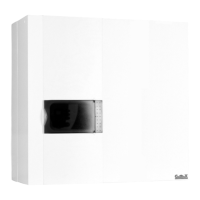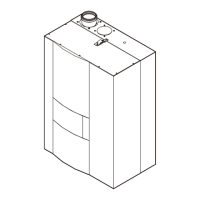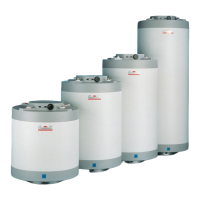23(5$7,21
)81&7,216&20021727+(',))(5(179(56,216
)RU WKHVH IXQFWLRQV WR ZRUN DQWL
IUHH]HSXPSNLFNDXWRPDWLFZLQWHU
VXPPHU VZLWFKLQJ DQWLOHJLRQHOOD
HWF WKH RQRII VZLWFK PXVW QRW EH
RSHUDWHG QHHGV WR EH NHSW SHUPD
QHQWO\LQWKH³RQ´SRVLWLRQ
$QWLIUHH]H IXQFWLRQ ZLWK 4$& RUDQG
4$$
Antifreeze protection for the boiler: When boiler tem-
perature is below 5 °C the burner and the heating
circuit pump are switched on. When the temperature
increases and exceeds 15 °C the burner is discon-
nected and the pump continues to circulate for
10 mins.
Antifreeze protection for the installation: The heating
pump starts operating automatically either intermit-
tently or continuously depending on whether the ex-
ternal temperature is under 1.5 °C or under -10 °C.
Antifreeze protection for the house : When the boiler
is equipped with a QAA70. Protection is provided by
maintaining ambient temperature at a minimum of
5 °C.
Antifreeze protection for domestic hot water: When
hot water production has shut down, a minimum
temperature of 4 °C is guaranteed by the regulator.
$QWLOHJLRQHOODIXQFWLRQ
To provide a degree of protection against the devel-
opment of pathogenic bacteria in the hot water tank
during prolonged shut-downs, the domestic hot wa-
ter needs to be heated once a week to above 60 °C.
The anti-legionella function is used for this purpose.
It heats the hot water storage tank once a week to
an “anti-legionella” temperature of 65 °C.
3XPSUXQRQDIWHUWKHHQGRIKHDWLQJ
When heating ends, the circulating pump remains
on for a further 10 minutes.
In hot water storage systems, when water heating
ends, the circulating pump remains on until the boil-
er temperature drops below 70 °C. During this pump
run-on period, the by-pass valve remains in the “do-
mestic hot water feed” position.
%\SDVVYDOYHDQGSXPSNLFN
If during shut-downs either the heating circuit has
not operated or the bypass valve has not been
switched for more than about 24 hours, these are
activated for a period of about 5 seconds.
%RLOHURYHUKHDWSURWHFWLRQ
The regulator incorporates a temperature control
function; This can switch off the burner when the
temperature of the water in the boiler reaches the
maximum of 85 °C. The circulating pump remains
on until the real temperature of the water in the boil-
er drops below 79 °C. The burner is then allowed to
start up again.
A boiler overheat protection also exists.
When the safety thermostat activates, the heating
circuit circulating pump and the fan motor are
switched on for 10 minutes. The bypass valve
switches to the “heating” position.
This second safety system requires a manual reset
and
generates an alarm on the boiler. The reset but-
ton has to be pressed to return to normal operation.
$QWLVKRUW EXUQHU F\FOH SURWHFWLRQ
IXQFWLRQ
The minimum time that the burner can operate is set
to 60 seconds.
$GDSWLQJWRDQH[WHUQDOVROHQRLGVDIHW\
YDOYH
When using liquefied gas, the system can be adapt-
ed at output ST9 to use an external solenoid safety
valve.
Index 5 signalling output is programmed as follows:
Output ST9 is on from phase 30 (fan speed rise
time) to phase 50 (regulator ends heat demand).
Supply: AC - 230 V + 10 % / - 15%
I < 1,0 A ; cosϕ > 0,8
)XQFWLRQV DFWLYDWHG XVLQJ WKH FRQWURO
SDQHO
6ZHHSIXQFWLRQGLVSOD\FRGH
The sweep function is activated by pressing % for at
least one second, i.e. when a demand for heating is
made so that the system comes on. The regulator’s
internal “on-off” functions remain inactive in this sit-
uation. The heating then operates at maximum heat
output until the temperature controller responds (to
take the sweep function flue gas measurements).
!
,QGH[
ELW
,QGH[
ELW
,QGH[
ELW
,QGH[
ELW
1000 or 1
